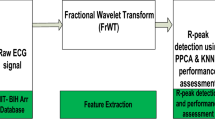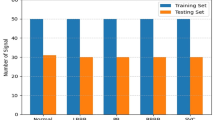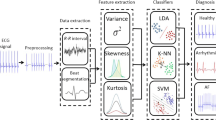Abstract
The electrocardiogram (ECG) is a widely disseminated method for detecting heart diseases due to its lower cost than other tests. But, some steps are important for detecting cardiac arrhythmias in ECG signals, which are: preprocessing, segmentation, feature extraction and classification. In this work, we assess how four non-morphological feature extraction methods provide useful ECG classification. Moreover, we propose an innovation in the configuration of the structural co-occurrence matrix (SCM), by combining it with the Fourier transform to extract the main frequencies of the signal. We tested theses methods on four well-known classifiers used in the literature and compare the results with six classical feature extraction methods. Moreover, we followed high standard protocols for developing expert systems for clinical usage. The database chosen for evaluation is the MIT-BIH arrhythmia database. We increased the identification of heart dysrhythmia by 2%, representing an advance on reports on the literature. The developed system is 1.3% more reliable than the current best approach reported, being \(10^6\) times faster, as well. The HOS with naive Bayes classified pathologies in 22 patients with 94.3% of accuracy. We perceived that SCM–Fourier is 1.5% more accurate than the SCM or Fourier standalone. The feature extractor proposed in this paper compress 97% of the useful information to provide a reliable arrhythmia classification.






Similar content being viewed by others
References
U.R. Acharya, V.K. Sudarshan, J.E.W. Koh, R.J. Martis, J.H. Tan, S.L. Oh, A. Muhammad, Y. Hagiwara, M.R.K. Mookiah, K.P. Chua, K.C. Chua, R.S. Tan, Application of higher-order spectra for the characterization of coronary artery disease using electrocardiogram signals. Biomed. Signal Process. Control 31, 31–43 (2017). ISSN 1746-8094
R.G. Afkhami, G. Azarnia, M.A. Tinati, Cardiac arrhythmia classification using statistical and mixture modeling features of ECG signals. Pattern Recognit. Lett. 70, 45–51 (2016). ISSN 0167-8655
ANSI/AAMI, Testing and Reporting Performance Results of Cardiac Rhythm and ST Segment Measurement Algorithms. Technical report, Association for the Advancement of Medical Instrumentation (American National Standards Institute, Inc. (ANSI), 2008)
J. Antoni, The spectral kurtosis: a useful tool for characterising non-stationary signals. Mech. Syst. Signal Process. 20(2), 282–307 (2006)
R. Arvanaghi, S. Daneshvar, H. Seyedarabi, A. Goshvarpour, Classification of cardiac arrhythmias using arterial blood pressure based on discrete wavelet transform. Biomed. Eng. Appl. Basis Commun. 29(05), 1750034 (2017)
J. Bergstra, Y. Bengio, Random search for hyper-parameter optimization. J. Mach. Learn. Res. 13, 281–305 (2012). ISSN 1532-4435
V. Capdevielle, C. Serviere, J. Lacoume, Blind separation of wide-band sources: application to rotating machine signals, in European Signal Processing Conference, 1996 (EUSIPCO 1996), 8th edn. (IEEE, 1996), pp. 1–4
P. Chazal, M. O’Dwyer, R.B. Reilly, Automatic classification of heartbeats using ECG morphology and heartbeat interval features. IEEE Trans. Biomed. Eng. 51(7), 1196–1206 (2004). ISSN 0018-9294
R. Dwyer, Detection of non-Gaussian signals by frequency domain kurtosis estimation. in Acoustics, Speech, and Signal Processing, IEEE International Conference on ICASSP’83, vol 8 (IEEE, 1983), pp. 607–610
O.K. Ersoy, A comparative review of real and complex Fourier-related transforms. Proc. IEEE 82(3), 429–447 (1994)
R.A. Fisher, On the mathematical foundations of theoretical statistics. Philos. Trans. R. Soc. Lond. A 222(594–604), 309–368 (1922)
G. Goertzel, An algorithm for the evaluation of finite trigonometric series. Am. Math. Mon. 65, 34–35 (1958)
R.C. Gonzalez, R.E. Woods, S.L. Eddins et al., Digital Image Processing Using MATLAB, vol. 624 (Pearson/Prentice-Hall, Upper Saddle River, 2004)
I. Güler, E.D. Übeylı, Ecg beat classifier designed by combined neural network model. Pattern Recognit. 38(2), 199–208 (2005). ISSN 0031-3203
S. Haykin, Neural Networks: Principles and Practice. Bookman (2001)
B. Hemmeryckx, Y. Feng, L. Frederix, M. Lox, S. Trenson, R. Vreeken, H.R. Lu, D. Gallacher, Y. Ni, H.R. Lijnen, Evaluation of cardiac arrhythmic risks using a rabbit model of left ventricular systolic dysfunction. Eur. J. Pharmacol. 832, 145–155 (2018). ISSN 0014-2999
G. Israel, S. Ayelet, E. Yair, D.R. Zwas, L. Chaim, K. Andre, Temporal changes in electrocardiographic frontal QRS-T angle and survival in patients with heart failure. PLoS ONE 13(3), e0194520 (2018)
D.P. Kingma, J.Ba. Adam, A method for stochastic optimization. CoRR, arXiv:1412.6980 (2014)
K. Kirti, Accurate interpretation of the 12-lead ECG electrode placement: a systematic review. Health Educ. J. 73(5), 610–623 (2014). ISSN 0017-8969
F. Li, G. Meng, L. Ye, P. Chen, Wavelet transform-based higher-order statistics for fault diagnosis in rolling element bearings. J. Vib. Control 14(11), 1691–1709 (2008)
C.-C. Lin, C.-M. Yang, Heartbeat classification using normalized RR intervals and morphological features. Math. Probl. Eng. 2014, 1–11 (2014). https://doi.org/10.1155/2014/712474
M. Llamedo, J.P. Martínez, Heartbeat classification using feature selection driven by database generalization criteria. IEEE Trans. Biomed. Eng. 58(3), 616–625 (2011)
E.J.S. Luz, T.M. Nunes, V.H.C. Albuquerque, J.P. Papa, D. Menotti, Ecg arrhythmia classification based on optimum-path forest. Expert Syst. Appl. 40(9), 3561–3573 (2013). ISSN 0957-4174
E.J.S. Luz, W.R. Schwartz, G. Cámara-Chávez, D. Menotti, ECG-based heartbeat classification for arrhythmia detection: a survey. Comput. Methods Progr. Biomed. 127, 144–164 (2016). ISSN 0169-2607
J.P.V. Madeiro, P.C. Cortez, J.A.L. Marques, C.R.V. Seisdedos, R.M.R. Sobrinho Carlos, An innovative approach of QRS segmentation based on first-derivative, Hilbert and wavelet transforms. Med. Eng. Phys. 34(9), 1236–1246 (2012)
J.A.L. Marques, P.C. Cortez, J.P.V. Madeiro, V.H.C. de Albuquerque, S.J. Fong, F.S. Schlindwein, Nonlinear characterization and complexity analysis of cardiotocographic examinations using entropy measures. J. Supercomput. (2018). https://doi.org/10.1007/s11227-018-2570-8. ISSN 1573-0484
H.R. Martin, F. Honarvar, Application of statistical moments to bearing failure detection. Appl. Acoust. 44(1), 67–77 (1995)
J.M. Mendel, Tutorial on higher-order statistics (spectra) in signal processing and system theory: theoretical results and some applications. Proc. IEEE 79(3), 278–305 (1991). ISSN 0018-9219
S. Mendis, Global Status Report on Noncommunicable Diseases 2014 (World Health Organization, Geneva, 2014)
G.B. Moody, R.G. Mark, The impact of the MIT-BIH arrhythmia database. IEEE Eng. Med. Biol. Mag. 20(3), 45–50 (2001)
K. Najarian, R. Splinter, Biomedical Signal and Image Processing (CRC Press, Boca Raton, 2005)
N.M. Nasrabadi, Pattern recognition and machine learning. J. Electron. Imaging 16(4), 049901 (2007)
J.P. Papa, A.X. Falcao, C.T.N. Suzuki, Supervised pattern classification based on optimum-path forest. Int. J. Imaging Syst. Technol. 19(2), 120–131 (2009)
S.A. Peixoto, Rebouças Filho, Neurologist-level classification of stroke using a structural co-occurrence matrix based on the frequency domain. Comput. Electr. Eng. 71, 398–407 (2018). ISSN 0045-7906
PhysioBank PhysioToolkit, Physionet: components of a new research resource for complex physiologic signals. Circulation v101 i23, e215–e220 (2000)
P. Pławiak, Novel methodology of cardiac health recognition based on ECG signals and evolutionary-neural system. Expert Syst. Appl. 92, 334–349 (2018)
A. Rahhal, M. Mohamad, Y. Bazi, H. AlHichri, N. Alajlan, F. Melgani, R.R. Yager, Deep learning approach for active classification of electrocardiogram signals. Inf. Sci. 345, 340–354 (2016)
G.L.B. Ramalho, D.S. Ferreira, P.P. Rebouças Filho, F.N.S. de Medeiros, Rotation-invariant feature extraction using a structural co-occurrence matrix. Measurement 94, 406–415 (2016)
P.P. Rebouças Filho, N.M.M. Nascimento, I.R. Sousa, C.M.S. Medeiros, V.H.C. Albuquerque, A reliable approach for detection of incipient faults of short-circuits in induction generators using machine learning. Comput. Electr. Eng. 71, 440–451 (2018)
P.P. Rebouças Filho, S.A. Peixoto, R.V. Medeiros da Nóbrega, D.J. Hemanth, A.G. Medeiros, A.K. Sangaiah, V.H.C. de Albuquerque, Automatic histologically-closer classification of skin lesions. Comput. Med. Imaging Graph. 68, 40–54 (2018). https://doi.org/10.1016/j.compmedimag.2018.05.004
R. Saktheeswari, K. Adalarasu, Survey on signal processing techniques for diagnoising cardiovascular diseases, in 2017 International Conference on Innovations in Information, Embedded and Communication Systems (ICIIECS) (2017), pp. 1–4
B. Samanta, K.R. Al-Balushi, Artificial neural network based fault diagnostics of rolling element bearings using time-domain features. Mech. Syst. Signal Process. 17(2), 317–328 (2003)
S.P. Silva, L.B. Marinho, J.S. Almeida, P.P. Rebouças Filho, A novel approach for mobile robot localization in topological maps using classification with reject option from structural co-occurrence matrix, in International Conference on Computer Analysis of Images and Patterns (Springer, Berlin, 2017), pp. 3–15
M.H. Song, J. Lee, S.P. Cho, K.J. Lee, S.K. Yoo, Support vector machine based arrhythmia classification using reduced features. Int. J. Control Autom. Syst. 3(4), 571–579 (2005)
J.W.M. de Souza, S.S.A. Alves, E.S. Rebouças, J.S. Almeida, P.P. Rebouças Filho, A new approach to diagnose parkinson’s disease using a structural cooccurrence matrix for a similarity analysis. Comput. Intell. Neurosci. 2018, 1–8 (2018). https://doi.org/10.1155/2018/7613282
V.N. Vapnik, An overview of statistical learning theory. IEEE Trans. Neural Netw. 10(5), 988–999 (1999)
J. Wang, Q. Chen, Y. Chen, RBF kernel based support vector machine with universal approximation and its application, in eds. by F. Yin, J. Wang, C. Guo, Advances in Neural Networks (Springer, Berlin, 2004), pp. 512–517. ISBN 978-3-540-28647-9
C. Ye, M.T. Coimbra, B.V.K.V. Kumar, Arrhythmia detection and classification using morphological and dynamic features of ECG signals, in Engineering in Medicine and Biology Society (EMBC), 2010 Annual International Conference of the IEEE (IEEE, 2010), pp. 1918–1921
S. Yu, Y. Chen, Electrocardiogram beat classification based on wavelet transformation and probabilistic neural network. Pattern Recognit. Lett. 28(10), 1142–1150 (2007)
S. Yu, K. Chou, Integration of independent component analysis and neural networks for ECG beat classification. Expert Syst. Appl. 34(4), 2841–2846 (2008)
Acknowledgements
We acknowledge the sponsorship from the Coordination for the Coordenação de Aperfeiçoamento de Pessoal de Nível Superior—Brasil (CAPES) by providing financial support. This study was financed in part by CAPES—Finance Code 001.
Author information
Authors and Affiliations
Corresponding author
Ethics declarations
Conflict of interest
The authors declare that they have no conflict of interest.
Additional information
Publisher's Note
Springer Nature remains neutral with regard to jurisdictional claims in published maps and institutional affiliations.
Rights and permissions
About this article
Cite this article
Nascimento, N.M.M., Marinho, L.B., Peixoto, S.A. et al. Heart Arrhythmia Classification Based on Statistical Moments and Structural Co-occurrence. Circuits Syst Signal Process 39, 631–650 (2020). https://doi.org/10.1007/s00034-019-01196-w
Received:
Revised:
Accepted:
Published:
Issue Date:
DOI: https://doi.org/10.1007/s00034-019-01196-w




